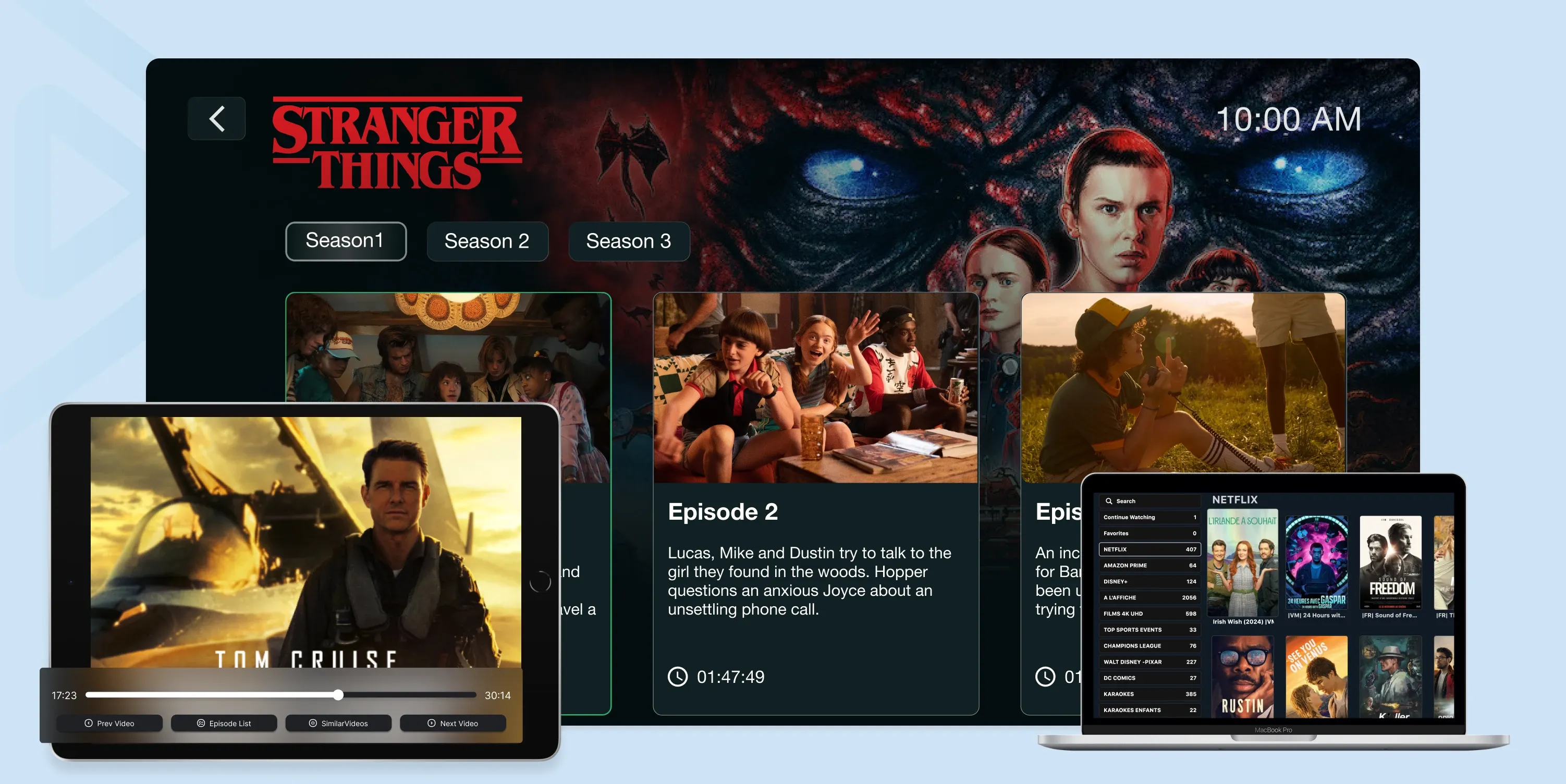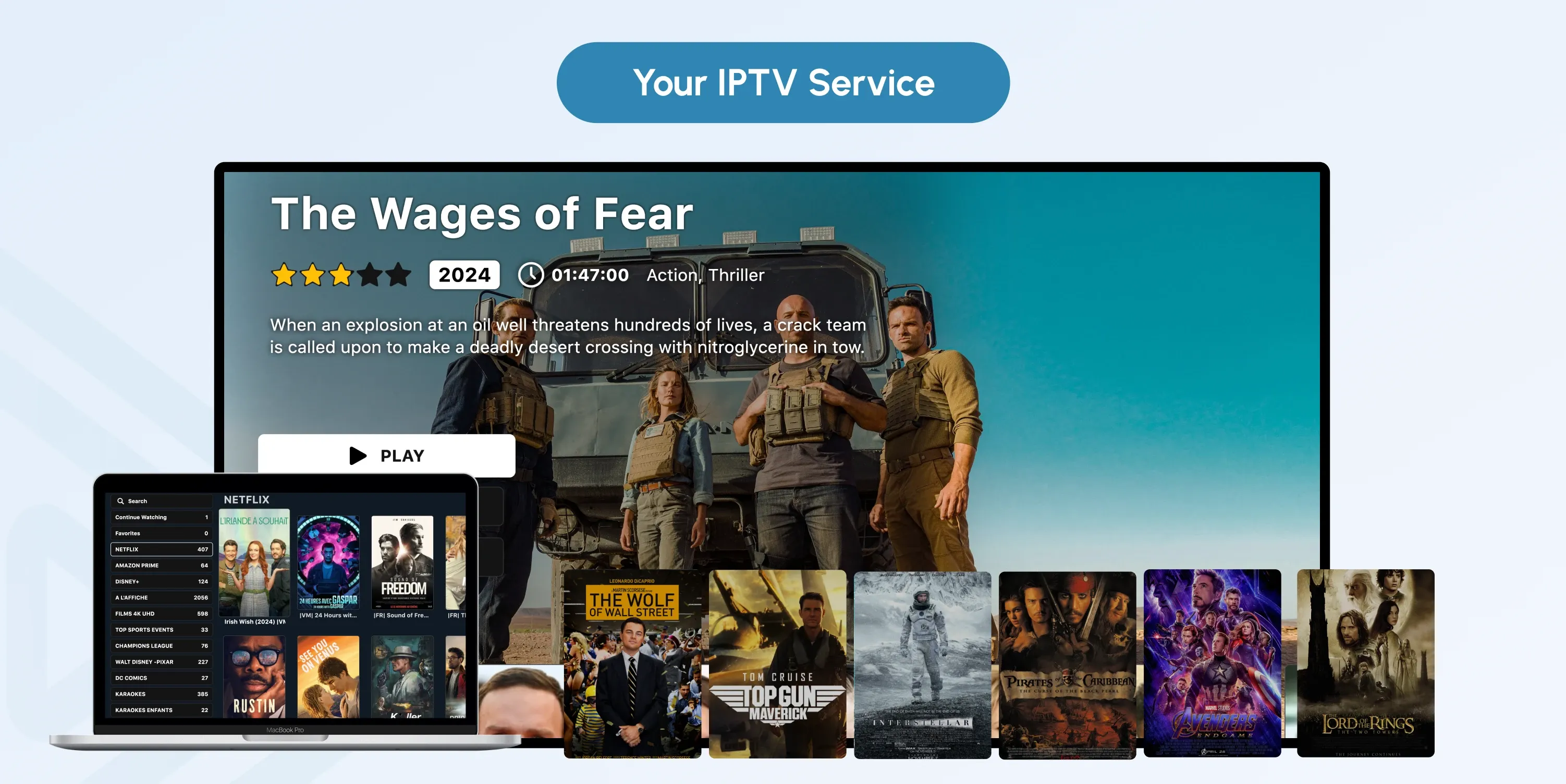
How to Start an IPTV Business: IPTV Platform Business Model
IPTV delivers TV shows over the internet instead of through cable or satellite—and it’s becoming a favorite for businesses because it's flexible, efficient, and easy to manage.
Big names like Google Play, Amazon Video, and Hulu have already attracted millions of users with their IPTV business models, so there’s no doubt this industry is booming.
If you're thinking about starting your own IPTV business, you're reading the perfect piece.
In this article, we’ll cover everything you need to get started—from market research to growing a loyal customer base. Let’s dive in and explore how to become an IPTV provider.

What is IPTV?
Unlike broadcast, cable, or satellite TV, IPTV (Internet Protocol Television) delivers television programs and multimedia content through the Transmission Control Protocol/Internet Protocol (TCP/IP) suite. This means an IPTV service—usually offered by a provider—streams live TV shows or on-demand video content over IP networks, giving viewers more flexibility in how they watch TV.
The IPTV industry is expected to grow rapidly in the coming years, with a projected compound annual growth rate of 16.8%. By 2032, the IPTV market could be worth approximately $276 billion.
This growth is driven by the increasing popularity of Video on Demand (VOD) and the demand for high-quality channels. Unlike traditional TV, IPTV offers a vast range of channels and services to enhance the viewing experience.
With IPTV, users can choose from several services, such as VOD, which gives direct access to a library of movies. Viewers can pick any movie from the VOD server and watch it whenever they like.
Another option is Near Video on Demand (NVOD), which offers pay-per-view access to selected shows for those with a subscription. Viewers get access to premiering or exclusive content at scheduled times, usually before normal on-demand platforms.
One of the most popular IPTV services is time-shifted TV, which allows users to watch live TV shows at a later time with the option to pause and resume the content whenever convenient.
Similarly, TV on Demand (TVOD) lets users access specific TV series whenever they want. And, of course, Live TV gives viewers the ability to watch the latest episodes as they air, and, in some cases, even interact with the show in real time.
Research and Planning
To successfully start your IPTV business, thorough research and careful planning are essential. Understanding your target audience's needs will help you identify the best opportunities to offer new services. For instance, if home theater setups are becoming increasingly popular, creating an IPTV business model focused on movie streaming could be a great idea.
Your research should include analyzing competitors to see how they operate. This will help you spot what works and identify any gaps in the market that other companies may be overlooking. Extensive market research is key to developing profitable strategies for your IPTV business solution. For example, if you’re targeting students, consider offering free trials, discounts, or creating a special plan tailored just for them.
Legal and Regulatory Considerations
When entering the broadcasting industry, it's crucial to understand the regulations and licensing requirements that apply. These guidelines help ensure your IPTV business model stays compliant with the law and minimizes the risk of legal issues down the road.
Some production companies may prefer upfront payments for their content, while others might opt for ongoing fees. Additionally, many companies have specific policies regarding how their content can be used, and these must be strictly followed.
To build a diverse and engaging content library, you’ll need to arrange licensing agreements with various content producers, manufacturers, and broadcasters. This requires strong negotiation skills to secure favorable terms. It’s also essential to comply with all copyright laws and regulations to protect your business and avoid potential legal complications.
Technical Setup
Learning how to setup your own IPTV service comes with understanding the technical aspects. Hosting your IPTV service and ensuring information security relies heavily on using a Virtual Private Server (VPS).
While it’s possible to build your own IPTV streaming server or host IPTV on a personal computer, opting for a hosting package from a reliable provider is often more cost-effective and dependable.
To optimize your VPS and efficiently handle client requests while delivering online video content, installing a robust web server is essential. The content distribution process depends on setting up the right encoding software and streaming protocols.
A successful configuration often includes integrating the Real-Time Messaging Protocol (RTMP) module into NGINX to enable smooth data flow, along with FFmpeg as the video encoder and compressor.
To deliver your IPTV content quickly and without interruptions, consider using a content delivery network (CDN).
A CDN consists of a network of caching servers located around the globe, ensuring that users can access content from the server closest to them. This approach improves stream responsiveness, reduces latency, and significantly enhances the viewing experience for your audience.
Monetization Strategies
As you explore the available IPTV business opportunities, consider your desired monetization strategy.
Here are some of the best monetization strategies
| Monetization Strategy | Description | Best For |
|---|---|---|
| Subscription-Based Model | Users pay a recurring fee (monthly or annually) for access to a curated selection of channels or an extensive content library. Pricing and content can be adjusted based on user feedback and analytics. | Businesses looking for stable, predictable revenue and long-term customer retention. |
| Advertising-Based Model | Ads are placed before, during, or after content. Targeted ads can be shown based on user data, such as viewing habits and demographics, maximizing effectiveness. | Businesses with a large user base willing to watch free content in exchange for ads. |
| Pay-Per-View (One-Time Payments) | Users pay a one-time fee to access specific content, such as movies, shows, or live events, without long-term commitments. | Businesses catering to event-based content or premium on-demand content consumers. |
Marketing and Customer Acquisition
Once you start your own IPTV business, creating a solid marketing plan is essential to attract a wide range of viewers. Start by outlining your goals—whether it's hitting a specific revenue target or reaching a certain number of users.
Next, think about the best ways to promote your IPTV service to your target audience. You might use social media, online ads, blog posts, or other methods to reach potential customers. Utilizing multiple channels is important because different strategies appeal to different customer groups.
For example, online ads can help bring in paid users, but they can also increase your operational costs. On the other hand, email marketing with newsletters is a cost-effective way to engage interested individuals and eventually convert them into paying subscribers.
Creating promotional videos or trailers is another great way to showcase the unique features, content, and user interface of your IPTV service. These trailers help capture attention and give potential customers a preview of what your platform offers.
Launching Your IPTV Service
Understanding how to start your own IPTV service requires careful planning and execution to ensure a smooth launch. The first step is selecting a reliable, flexible streaming platform that can manage all your IPTV services.
Look for a robust, all-in-one IPTV business solution that offers key features like content management, data analytics, and user management to help your service run efficiently.
 Next, choose a trustworthy Content Delivery Network (CDN) to ensure high-quality, seamless streaming on all devices, regardless of location. The right CDN will reduce latency, ensuring your users enjoy smooth streaming, no matter where they are or what device they're using.
Next, choose a trustworthy Content Delivery Network (CDN) to ensure high-quality, seamless streaming on all devices, regardless of location. The right CDN will reduce latency, ensuring your users enjoy smooth streaming, no matter where they are or what device they're using.
Investing in a well-designed, user-friendly interface (UI) is equally important. A good UI enhances the user experience by making navigation easy, making content search simple, and offering customizable options. This ensures that users feel engaged and satisfied with your service.
Pricing is another critical decision to make before launching your business. Consider factors like content costs, market competition, and your target audience's budget when setting your prices. Offering multiple payment options—monthly, quarterly, or annual subscriptions—can also make your service more appealing to a broader audience.
Finally, thorough testing is essential to identify and resolve any technical issues or performance bottlenecks. Consider offering a limited test release to a small group of early users. Their feedback will help you make any necessary adjustments before the official launch.
Scaling Your IPTV Business
To keep your IPTV business model running smoothly as it grows, you need to focus on scaling your services effectively. This involves increasing capacity, upgrading infrastructure, and optimizing operations so you can handle more users and content while maintaining high-quality performance.
Start by expanding the capacity and bandwidth of your server to accommodate the growing number of subscribers. As your user base increases, you may need to add resources to your Virtual Private Server (VPS) or upgrade your server hardware. Taking these steps ensures that your platform can manage multiple streams simultaneously, without issues like buffering or service interruptions.
That said, you can skip the hassle of upgrading server hardware with a cloud-based IPTV business solution.
Improving your Content Delivery Network (CDN) is also crucial for scaling. You can either add more nodes in strategic locations or partner with a reputable CDN provider to enhance content delivery. This will help reduce latency and ensure faster, smoother streaming for your users, no matter where they are.
Conclusion
Learning how to start an IPTV business can be highly profitable as more consumers seek flexible, online-based TV solutions. By navigating the legal and regulatory landscape, setting up the right technical infrastructure, and implementing smart marketing strategies, you can build a successful and scalable IPTV service.
Each step—from choosing the best streaming platform and Content Delivery Network to offering diverse content and a seamless user interface—plays a crucial role in delivering an exceptional viewing experience.
Frequently Asked Questions
Co-founder / CTO
Armen is the CTO and Co-Founder of inoRain OTT and Co-Founder of HotelSmarters, specializing in advanced streaming technologies, OTT strategy, and interactive TV systems. He builds scalable end-to-end video delivery solutions and drives technical innovation across hospitality and streaming platforms, bridging complex engineering with practical business impact.

How to Develop a Video Streaming App: Best Practices
Learn the basics of developing a modern video streaming app. This guide covers key best practices to help you build the right way from the start.

How to Make a Short Video App (2026 Complete Guide)
Learn how to build a short video app in 2026. Explore micro-drama trends, key features, monetization models, and step-by-step development insights.

OTT Advertising: Types, Best Practices, and Strategies
Over-the-top (OTT) advertising has transformed how brands connect with consumers.

